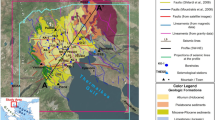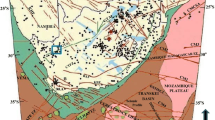Abstract
A compiled gravity anomaly map of the Western Himalayan Syntaxis is analysed to understand the tectonics of the region around the epicentre of Kashmir earthquake of October 8, 2005 (Mw = 7.6). Isostatic gravity anomalies and effective elastic thickness (EET) of lithosphere are assessed from coherence analysis between Bouguer anomaly and topography. The isostatic residual gravity high and gravity low correspond to the two main seismic zones in this region, viz. Indus–Kohistan Seismic Zone (IKSZ) and Hindu Kush Seismic Zones (HKSZ), respectively, suggesting a connection between siesmicity and gravity anomalies. The gravity high originates from the high-density thrusted rocks along the syntaxial bend of the Main Boundary Thrust and coincides with the region of the crustal thrust earthquakes, including the Kashmir earthquake of 2005. The gravity low of HKSZ coincides with the region of intermediate–deep-focus earthquakes, where crustal rocks are underthrusting with a higher speed to create low density cold mantle. Comparable EET (∼55 km) to the focal depth of crustal earthquakes suggests that whole crust is seismogenic and brittle. An integrated lithospheric model along a profile provides the crustal structure of the boundary zones with crustal thickness of about 60 km under the Karakoram–Pamir regions and suggests continental subduction from either sides (Indian and Eurasian) leading to a complex compressional environment for large earthquakes.
Similar content being viewed by others
References
Avouac JP, Ayoule F, Sebastien L, Konca O, Helmberger DV (2006) The 2005, Mw 7.6 Kashmir earthquake: sub-pixel correlation of ASTER images and seismic wave forms analysis. Earth Planet Sci Lett 249:514–528
Bhukta SK, Sain K, Tewari HC (2006) Crustal structure along the Lawrencepur–Astor profile in the north west Himalayas. Pure Appl Geophys 163:1257–1277
Burov EB, Watts AB (2006) The long-term strength of continental lithosphere: “jelly sandwich” or “crème brûlée”? GSA Today: v. 16, no. 1, DOI 10.1130/1052-5173
Caporali A (1995) Gravity anomalies and the flexure of the lithosphere in the Karakoram, Pakistan. J Geophys Res 100:15075–15085
Caporali A (2000a) The gravity field of the Karakoram Mountain Range and surrounding areas, In: Khan MA, Treloar PJ, Searle MP, Jan MQ (eds) Tectonics of Nanga Parbat syntaxis and the Western Himalaya, Geol. Soc., London, Special Publications 170:7–23
Caporali A (2000b) Buckling of the lithosphere in Western Himalaya, constraints from gravity and topography data. J Geophys Res 105:3103–3113
Chatelain JL, Roecker SW, Hatzfeld D, Molnar P (1980) Micro earthquake seismicity and fault plane solutions in the Hindukush region and their tectonic implications. J Geoph Res 85:1365–1387
Duroy Y, Farah A, Lillie RJ (1989) Subsurface densities and lithospheric flexure of the Himalayan foreland in Pakistan. In: Malinconica LL Jr, Lillie RJ (eds) Tectonics of the Western Himalayas. Geol Soc Am Special Paper 232:217–236
England PC, McKenzie DP (1982) A thin viscous sheet model for continental deformation. Geophys J R Astron Soc 70:295–321
Forsyth DW (1985) Subsurface loading and estimates of the flexural rigidity of continental lithosphere. J Geoph Res 90:12623–12632
GSI-NGRI (2006) Gravity anomaly maps of India on 1:2 Million scale published by Geological Survey of India and National Geophysical Research Institute, Hyderabad, India
Jackson J (2002) Strength of the continental lithosphere: time to abandon the jelly sandwich? GSA Today, 4–10
Koulakov I, Sobalev SV (2006) Atomographic image of Indian lithosphere break off beneath the Pamir–Hindu Kush region. Geophys J Int 164:425–440
Kumar P, Yuan X, Kind R, Kosarev G (2005) The lithosphere–asthenosphere boundary in the Tien Shan–Karakoram region from S receiver functions, evidence for continental subduction. Geoph Res Lett 32:L07305 1–4
Lowry AR, Smith RB (1994) Flexural rigidity of the Basin and Range–Colorado Plateau–Rocky Mountain transition from the coherence analysis of gravity and topography. J Geophys Res 99:20 123–20, 140
McKenzie DP, Fairhead JD (1997) Estimates of the effective elastic thickness of the continental lithosphere from Bouguer and free air gravity anomalies. J Geophys Res 102:27523–27552
Mishra DC, Rajasekhar RP (2006) Crustal structure at the epicentral zone of 2005 Kashmir (Muzzafarahad) earthquake and seismotectonic significance of lithospheric flexure. Curr Sci 90:1406–1412
Mishra DC, Laxman G, Arora K (2004) Large wavelength gravity anomalies over the Indian continent: Indicators of lithospheric flexure and uplift and subsidence of Indian Peninsular Shield related to isostasy. Curr Sci 86:861–867
Negredo AM, Replumag A, Villasenor A, Guillot S (2007) Modelling the evolution of continental subduction processes in the Pamir–Hindu Kush region. Earth Planet Sci Lett 259:212–225
Ni J, Barazangi M (1984) Seismotectonics of the Himalayan collision zone, geometry of the under thrusting Indian plate beneath the Himalaya. J Geophys Res 89:1147–1163
Pegler G, Das S (1998) An enhanced image of the Pamir–Hindu Kush seismic zone obtained from relocated earthquake hypocenters. Geophys J Int 134:573–595
Seeber L, Armbruster JG, Quittmeyer RC (1981) Seismicity and continental subduction in the Himalayan arc In: Gupta HK, Delany FM (eds) Zagros, Hindukush, Himalaya, geodynamic evolution. Am Geophys Union & Geol Soc Am. Geodynamic Series 3:215–242
Tiwari VM, Rao MBSV, Mishra DC, Singh B (2006) Crustal structure across Sikkim, NE Himalaya from new gravity and magnetic data. Earth Planet Sci Lett 247:61–69
Treloar PJ, Rex DC, Guise PG, Wheeler J, Hurford AJ, Carter A (2000) Geochronological constraints on the evolution of the Nanga Parbat syntaxis, Pakistan Himalaya In: Khan MA, Treloar PJ, Searle MP, Jan MQ (eds) Tectonics of Nanga Parbat syntaxis and the Western Himalaya, Geol. Soc., London, Special Publications 170:137–162
UNESCO (1976) Bouguer Anomaly map of western ESCAP region, UNESCO Publication
USGS (2007) http://neic.usgs.gov/neis/epic-rect.html
Watts AB (2001) Isostasy and flexure of the lithosphere. Cambridge University Press, pp 1–458
Zhao Z, Nelson KD, Project INDEPTH Team (1993) Deep seismic reflection evidence for continental under thrusting beneath southern Tibet. Nature 366:557–559
Author information
Authors and Affiliations
Corresponding author
Rights and permissions
About this article
Cite this article
Tiwari, V.M., Rajasekhar, R.P. & Mishra, D.C. Gravity anomaly, lithospheric structure and seismicity of Western Himalayan Syntaxis. J Seismol 13, 363–370 (2009). https://doi.org/10.1007/s10950-008-9102-6
Received:
Accepted:
Published:
Issue Date:
DOI: https://doi.org/10.1007/s10950-008-9102-6




